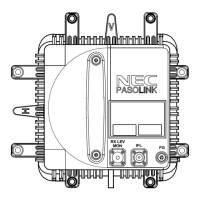ROI-S04488 FUNCTIONAL OPERATION
2-17
2.1 Transmit Line Equalization
This section describes the bipolar-to-unipolar code conversion,
multiplexing and parallel-to-serial conversion.
2.1.1 Bipolar-to-Unipolar Code Conversion
The signals applied to the TRAFFIC IN terminal are (*) 2.048 Mbps data
streams in a bipolar pulse format of the high density bipolar-3 (HDB-3)
code. Each bipolar-coded data stream is converted into an NRZ unipolar
data stream.
Note: *2 MB × 2 system: two
2 MB × 4 system: four
2 MB × 8 system: eight
2 MB × 16 system: sixteen
2.1.2 Multiplexing
To obtain time slots for multiplexing, the 2.048 Mbps × N data streams are
written in to a buffer memory and read out with radio section clock having
a time gap. The data streams having a time gap are sent to a multiplexer
(MUX) circuit, here, alarm information, AIS RCVD, loopback control/
answer, alarm/control signals and stuff information bits, etc. are inserted
into the location of the time gap.
2.1.3 Parallel-to-Serial Conversion
The signal streams which are formatted in radio frame, are fed to the DPU
circuit.
2.2 Transmit Digital Processing
This section describes the multiplexing, scrambling and parity check.
2.2.1 Multiplexing
The data streams having a time gap are sent to the MUX in which frame
pattern, multiframe pattern, analog service channel (ASC), digital service
channel (DSC), WS, LAN data signals and parity check bits are inserted
into the respective locations of the time gap. The multiplexed data streams
are fed to the SCRB circuit.

